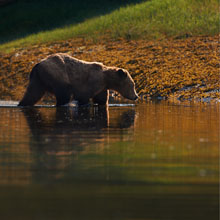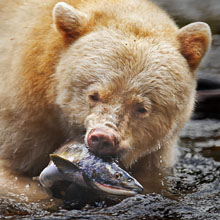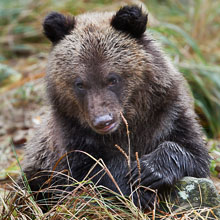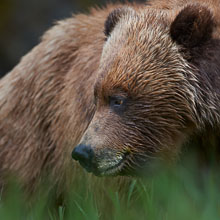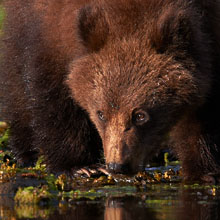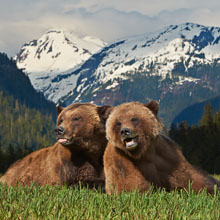Availability: Undetermined - Enquiries?
In the Field
Eye-to-Eye! Great Bear Rainforest, BC, Canada. September 29, 2009.
Because of National Geographic's cover story in their August 2011 edition featuring the Spirit Bear, the knowledge of their existence has become much more widespread. These extremely rare white bears (most authorities peg their number at between 200 and 300 individuals) are actually a coat colour variant of the "common" American Black Bear (Ursus americana). The white coat colour is produced by a recessive gene and theoretically Spirit Bears COULD pop up anywhere. Why almost all of them are found (and why the recessive gene is in such high frequency) in one small portion of the central British Columbia coast remains a bit of a mystery. In that region between 10 and 20% of the black bears have the white coat colour.
Each autumn I lead photo tours into the region the Spirit Bear calls home and provide a small group of photographers (6 per trip) with the opportunity to view and photograph these very unique bears. One of the things I have noticed over my years of photographing Spirit Bears is how darned hard it is to capture a good view (or photograph) of the eye of a Spirit Bear. Between the dark forest they're traditionally found in, the fact that they tend to have dark eyes, AND the fact that they tend to have fuller eyelashes than their black-coated brethren, it can be REALLY, REALLY tough to get a shot of Spirit Bear with a catch-light in its eye.
Back in 2009 the group of photographers I took in had some shooters in it that were just a tad competitive. We were fortunate enough to find a few Spirit Bears that were fishing. Well...you can guess where that lead to - before long it wasn't good enough to capture a shot of a Spirit Bear with its eye in focus and showing a catch-light - the new goal became capturing an image of a Spirit Bear with eye in focus showing a catch-light AND with a salmon in its mouth AND with the salmon's eye in focus AND showing a catch-light. Sheesh - I guess just capturing an image of one of the world's rarest bears simply isn't good enough anymore!
Anyway... being a totally non-competitive guy myself (yeah, right...) I have no idea who won the "Spirit Bear eye AND salmon eye in focus" contest. But...here ya go guys...try this one of for size!
ADDITIONAL NOTES:
1. This image - in all resolutions - is protected by copyright. I'm fine with personal uses of them (including use as desktop backgrounds or screensavers on your own computer), but unauthorized commercial use of the image is prohibited by law. Thanks in advance for respecting my copyright!
2. This image was captured during one of my autumn "Into the Great Bear Rainforest" photo tours in 2016. Each year I offer trips into two different parts of the Great Bear Rainforest as well as one to photograph marine mammals and oceanscapes near the northern tip of Vancouver Island. And, in selected years, I also offer photo tours to additional locations to capture other highly sought-after subjects, such as various boreal owl species, fishing grizzlies, and more. Details about these trips can be found on the Photo Tours page of this website.
3. Like all wildlife images on this website, the subject(s) is/are fully wild and completely unconstrained. Besides the potential impact of my/our presence, nothing has been done to intentionally alter or affect the ongoing behavior of the subject and, of course, there has been no use of any form of bait or other form of wildlife attractants (including vocalizations or other sounds).
Behind the Camera
Eye-to-Eye! Great Bear Rainforest, BC, Canada. September 29, 2009.
Digital Capture; RAW 14-bit format; ISO 200.
Nikon D3 with Nikkor 600mm f4 VRII lens supported on carbon fibre Gitzo 1348 tripod with Wimberley head.
1/320s @ f5.6; -0.67 stop compensation from matrix-metered exposure setting.
At the Computer
Eye-to-Eye! Great Bear Rainforest, BC, Canada. September 29, 2009.
RAW Conversion to 16-bit TIFF, including first-pass/capture sharpening using Phase One's Capture One Pro 6. Three raw conversions varying in exposure settings over a 1.5 stop range (from 0 stop adjustment through to a +1.5 stop exposure increase).
Further digital corrections on 16-bit TIFF file using Adobe's Photoshop CS5 and Light Crafts Light Zone. Adjustments including blending of 3 exposure versions, selective tone curve adjustment, selective colour saturation and desaturation, and final sharpening for web output. Final tonemapping and contrast/tone tweaking performed with LightZone using the tonemapper/re-light tool.
Conservation
Eye-to-Eye! Great Bear Rainforest, BC, Canada. September 29, 2009.
Ten percent of the revenue generated by this image will be donated to Raincoast*.
Species Status in Canada**: Not currently listed as Threatened or Endangered.
The "Spirit" Bear is a rare genetically-based colour variant of the common Black Bear (Ursus americana). It has been estimated that less than 300 Spirit Bears exist today. Because the Black Bear is not considered under threat as a species, the Spirit Bear suffers from having the same conservation designation (it should be acknowledged that in British Columbia - the jurisdiction of greatest Spirit Bear abundance - hunting of these white-coated bears is not permitted). For reasons that are not fully understood, the Spirit Bear occurs with greater frequency in a relatively small geographic area within The Great Bear Rainforest of the central and northern coast of British Columbia. In this area 10 to 30% of the bears possess white coats. Many of the black-coloured Black Bears in this region carry the gene for white coats, so allowing hunting of ANY Black Bears in this region can reduce the frequency of the gene for white coats. Thus, to protect the Spirit Bear, it is necessary to prohibit the hunting of ALL Black Bears in this region. And, very unfortunately, the globally unique ecosystem that contains the Spirit Bear is under development pressure, especially from the forestry industry. If this unique environment is altered, we may lose the wonderful genetic anomaly known as the Spirit Bear forever.
*The Raincoast Conservation Society (and Foundation) is an effective and efficient organization that has been fighting for protection of this unique habitat. If you are looking for a meaningful way to contribute to the conservation of this amazing ecosystem, Raincoast will provide maximal "bang" for your conservation dollars.
**as determined by COSEWIC: The Committee on the Status of Endangered Wildlife in Canada



















